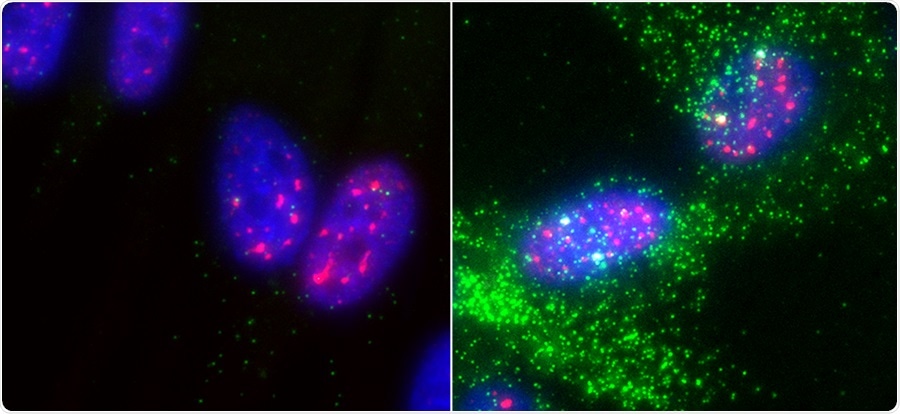Scientists from the Perelman School of Medicine at the University of Pennsylvania headed a group of researchers to unravel the functions of the so-called “nuclear speckles”—mysterious structures found in cells—demonstrating that they can function in collaboration with a crucial protein to improve the activities of particular sets of genes.

This image of cells shows p53 induction of a key p53 target. On the left are cells where p53 is not active; on the right, p53 has been activated. Each small green spot shows a single mRNA of the p53 target gene. The site where the gene is being transcribed in the nucleus is the bright green spot. Nuclear speckles are shown in red. Image Credit: Perelman School of Medicine, University of Pennsylvania.
Published in the Molecular Cell journal, the breakthrough is an advance in basic cell biology; the crucial protein it determines as a working partner of speckles is well known as a key tumor-inhibitor protein, p53. This area of study could also enable better future insights into cancers, and probably improved cancer treatments.
This study shows that nuclear speckles work as major regulators of gene expression, and suggests that they have a role in some cancers.”
Shelley Berger, PhD, Study Senior Author and Daniel S. Och University Professor, Department of Cell and Developmental Biology, Perelman School of Medicine, University of Pennsylvania
Nuclear speckles are minute structures found inside the nucleus of each mammalian cell. They were first observed in 1910 using a microscope. However, in the following 111 years, researchers have not discovered much about their functions.
According to one previous theory, the speckles are typically storage depots because they do have significant molecules required to copy out the DNA in genes into RNA transcripts and subsequently process those transcripts into the finished “messenger RNAs,” which can then be translated into proteins.
In the recent past, researchers started to collect proof that speckles have a more direct role in gene transcription. However, it has been challenging to identify their exact functions and how those are controlled. This is because of the basic difficulties encountered while investigating speckles.
As part of this study, Berger and team, which includes first author Katherine Alexander, Ph.D., a postdoctoral researcher in the Berger Laboratory who did a major portion of the experiments, solved a few of these difficulties to show that speckles join hands with p53 to directly improve the activity of specific genes.
For a long time, p53 has been known as a “transcription factor,” or master switch, that regulates the activity of a wide set of genes, but the team demonstrated that it exerts this effect on a subset of its target genes through nuclear speckles.
The protein serves as a matchmaker by bringing together speckles and DNA that contains these target genes. When the genes and speckles come closer, the transcription level of the genes increases considerably.
The team took a step further and demonstrated that the p53 target genes with activity boosted by the speckles feature a set of functions that are widely different from those of other p53 target genes.
Speckle-associated p53 target genes, compared to other p53 target genes, are more likely to be involved in tumor-suppressing functions such as stopping cell growth and triggering cell suicide.”
Katherine Alexander, Postdoctoral Researcher, Perelman School of Medicine, University of Pennsylvania
The study results not just confirm nuclear speckles as promoters of gene activity but also involve them in the functions of a crucial tumor-suppressor protein, which is disrupted in nearly half of all cancers.
In certain types of cancers, p53 is mutated such that it not just loses its tumor-inhibiting function but also actively promotes cancerous growth. At present, the team is making efforts to identify whether nuclear speckles play a role in mediating such a cancer-inducing effect of mutant p53.
If that proves to be the case, then in principle we could develop treatments to interfere with this association between p53 and speckles—an association that might turn out to be a real Achilles heel for cancer.”
Shelley Berger, PhD, Study Senior Author and Daniel S. Och University Professor, Department of Cell and Developmental Biology, Perelman School of Medicine, University of Pennsylvania
Source:
Journal reference:
Alexander, K. A., et al. (2021) p53 mediates target gene association with nuclear speckles for amplified RNA expression. Molecular Cell. doi.org/10.1016/j.molcel.2021.03.006.